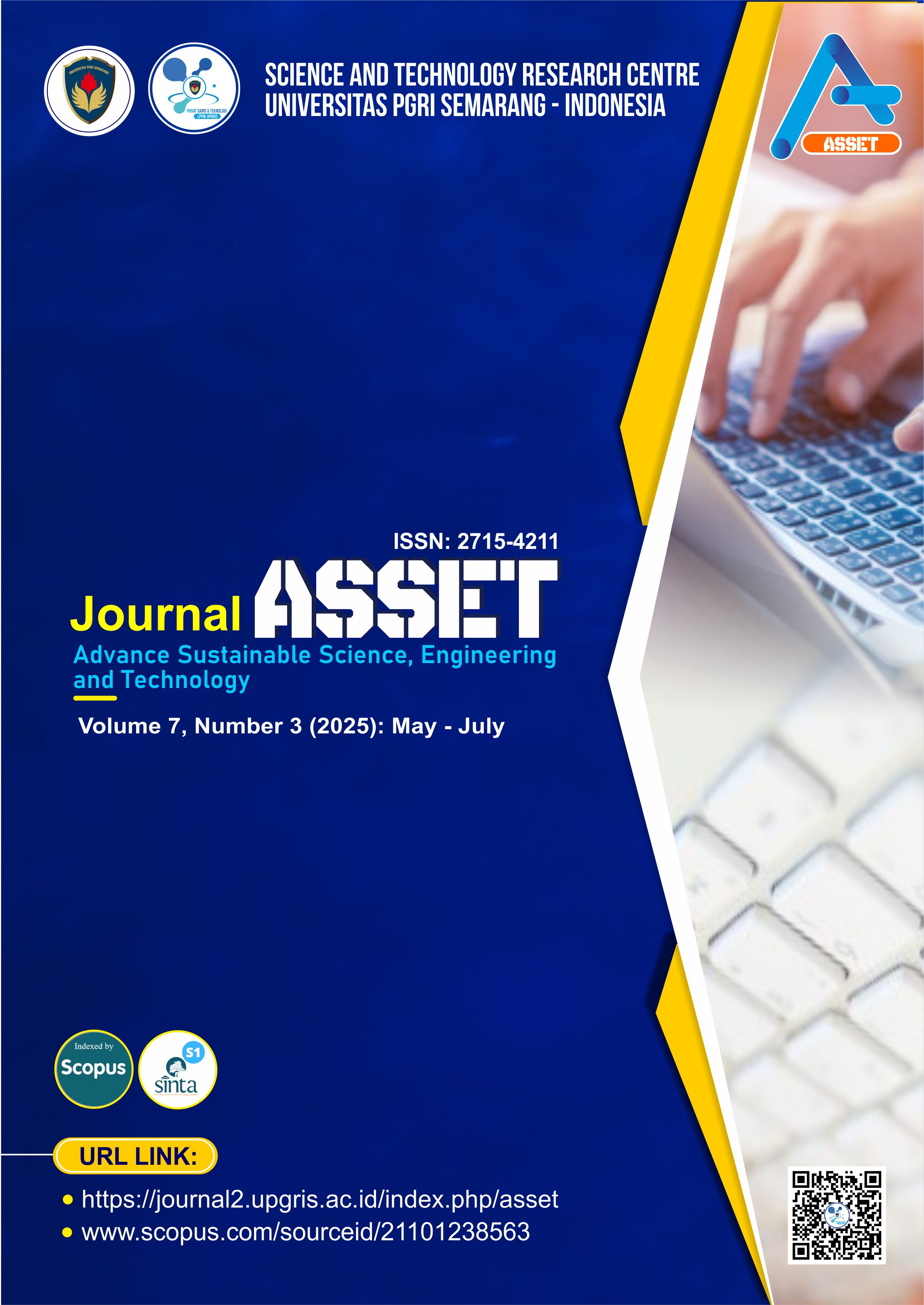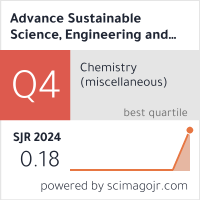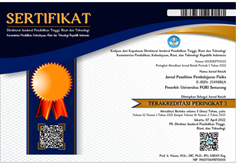Wear Behaviours of Sustainable Biolubricants: Influence of Fatty Acid Compositions and Surface Roughness in Mixed Lubrication Regimes
DOI:
https://doi.org/10.26877/asset.v7i3.1761Keywords:
vegetable oil-based lubricant, sustainable biolubricant, wear analysis, sustainable tribology, surface roughness, mixed lubrication regimeAbstract
The advantage of biolubricant compared to mineral oil is that biolubricant can ensure environmental sustainability. This research aims to investigate sustainable biolubricants of virgin coconut oil (VCO) and olive oil on wear behaviours with different fatty acid compositions and surface roughnesses in the mixed lubrication regimes. Tests were carried out on pin-on-disc equipment at a speed of 500 rpm with loads of 50 and 100 N. We used two types of biolubricants and surface roughness of the disks (0.8 and 6.3 µm). The research results show that the lauric acid content in VCO could reduce the wear rate of the disk. The surface roughness of the disc had a significant influence on the wear rate for both biolubricants; the smoother the surface of the disc, the more wear rate will decrease. The effect of surface roughness of the disc with both biolubricants could reduce the scar width of the disc and the scar diameter of the pin. The scar width of the disk was higher when compared to the scar diameter of the pin; by using VCO, there was a decrease of percentage in scar width of 32% by using smooth surface. VCO could be a promising sustainable bio-based lubricant in the future, especially in the mixed lubrication regimes
References
[1] Y. Xiao et al., “Tribological behavior of sliding contact with olive oil lubrication under high temperature condition,” Industrial Crops and Products, vol. 229, p. 120957, Apr. 2025, doi: 10.1016/j.indcrop.2025.120957.
[2] D. Gasni, H. Putra, N. Anoven, and M. D. Rahman, “Characteristics of physical and tribological properties of used lubricants from filtering process of a car engine,” AIP Conference Proceedings, vol. 2592, p. 050009, Jan. 2023, doi: 10.1063/5.0115916.
[3] J. R. Joshi, K. K. Bhanderi, and J. V. Patel, “Waste cooking oil as a promising source for bio lubricants- A review,” Journal of the Indian Chemical Society, vol. 100, no. 1, p. 100820, Dec. 2022, doi: 10.1016/j.jics.2022.100820.
[4] D. Gasni and H. Mulyadi, “Effect of extracting method of coconut oils on tribological properties as bio-based lubricant,” Istrazivanja I Projektovanja Za Privredu, vol. 20, no. 3, pp. 831–840, Jan. 2022, doi: 10.5937/jaes0-32294.
[5] C. Lu, “Study on prediction of surface quality in machining process,” Journal of Materials Processing Technology, vol. 205, no. 1–3, pp. 439–450, Dec. 2007, doi: 10.1016/j.jmatprotec.2007.11.270.
[6] G. Styles, R. Rahmani, H. Rahnejat, and B. Fitzsimons, “In-cycle and life-time friction transience in piston ring–liner conjunction under mixed regime of lubrication,” International Journal of Engine Research, vol. 15, no. 7, pp. 862–876, Feb. 2014, doi: 10.1177/1468087413519783.
[7] H. A. Spikes, “Mixed lubrication — an overview,” Lubrication Science, vol. 9, no. 3, pp. 221–253, May 1997, doi: 10.1002/ls.3010090302.
[8] B. J. Hamrock and D. Dowson, Trans., Ball bearing lubrication : The elastohydrodynamic of elliptical contacts. Newyork, United States of America: John Willey & Sons, 1981.
[9] D. Gasni, “Simulasi koefisien gesek untuk mixed lubrication model point Contact dengan kurva Stribeck,” Teknika, vol. 19, no. 2, pp. 28–42, 2012.
[10] D. Gasni, Tribologi untuk komponen mesin. Solok, Sumatra Barat, Indonesia: PT. Mafy Media Literasi Indonesia, 2024.
[11] A. Azam, A. Ghanbarzadeh, A. Neville, A. Morina, and M. C. T. Wilson, “Modelling tribochemistry in the mixed lubrication regime,” Tribology International, vol. 132, pp. 265–274, Dec. 2018, doi: 10.1016/j.triboint.2018.12.024.
[12] D. Gasni and S. Rahmat, “Menentukan regime pelumasan pada ball bearing dengan menggunakan kurva Stribeck,” Jurnal METTEK, vol. 3, no. 1, pp. 21–28, 2017.
[13] A. Ikhsan, D. Gasni, and M. Rusli, “Investigation of the coefficient of friction, wear, and surface morphology on a sliding contact area due to the large particle size of solid contaminants in grease,” International Journal of Abrasive Technology, vol. 12, no. 4, pp. 313–334, Jan. 2024, doi: 10.1504/ijat.2024.145179.
[14] S. M. Hsu and E. E. Klaus, “Some chemical effects in boundary lubrication Part I: Base Oil-Metal Interaction,” A S L E Transactions, vol. 22, no. 2, pp. 135–145, Jan. 1979, doi: 10.1080/05698197908982909.
[15] F.-X. Wang, P. Lacey, R. S. Gates, and S. M. Hsu, “A study of the relative surface conformity between two surfaces in sliding contact,” Journal of Tribology, vol. 113, no. 4, pp. 755–761, Oct. 1991, doi: 10.1115/1.2920689.
[16] M. T. Siniawski, N. Saniei, B. Adhikari, and L. A. Doezema, “Influence of fatty acid composition on the tribological performance of two vegetable‐based lubricants,” Lubrication Science, vol. 24, no. 2, pp. 101–110, Mar. 2007, doi: 10.1002/jsl.32.
[17] Charoo, F. Akhter, M. Hanief, W. K. Shafi, and M. Nissar, “Effect of saturated fatty acids on the antiwear and rheological properties of olive oil,” Tribology in Industry, vol. 45, no. 1, pp. 121–128, Mar. 2023, doi: 10.24874/ti.1404.11.22.02.
[18] G. Rajasozhaperumal and C. Kannan, “Influence of fatty acid composition on the tribological performance of methyl esters under boundary lubrication regime,” Arabian Journal for Science and Engineering, vol. 48, no. 3, pp. 3581–3597, Sep. 2022, doi: 10.1007/s13369-022-07232-3.
[19] “Industri kelapa Indonesia, dari kebun rakyat hingga pasar dunia,” Aug. 06, 2024. https://indonesia.go.id/kategori/editorial/8468/industri-kelapa-indonesia-dari-kebun-rakyat-hingga-pasar-dunia?lang=1#:~:text=Provinsi%20Riau%20menempati%20urutan%20teratas,hektare%20dan%20produksi%20233.937%20ton (accessed Apr. 11, 2025).
[20] F. D. Gunstone, Vegetable oils in Food Technology: Composition, properties and uses. Oxford, United Kingdom of Great Britain and Northern Ireland: Blackwell Publishing, 2002.
[21] E. Santoso, F. Fatkhurrohman, A. R. Firmansyah, and S. C. Putra, “Hardness and icrostructural characterization of pack carburizing AISI 1020 Low-Carbon steel by temperature and holding time variations,” Advance Sustainable Science Engineering and Technology, vol. 6, no. 1, p. 02401023, Jan. 2024, doi: 10.26877/asset.v6i1.17583.
[22] B. J. Hamrock. and D. Dowson, “Isothermal elastohydrodynamic lubrication of point contacts. i -Fully flooded results,” Journal of Lubrication Technology, vol. 99, no. 2, pp. 264–276, 1997.
[23] M. Simpson, R. Rahmani, N. Dolatabadi, N. Morris, D. Jones, and C. Craig, “An analytical friction model for point contacts subject to boundary and mixed elastohydrodynamic lubrication,” Tribology International, vol. 196, p. 109699, Apr. 2024, doi: 10.1016/j.triboint.2024.109699.
[24] D. Gasni, H. Putra, M. Ichwan, R. A. Perdana, and W. Annisa, “Wear and friction performances of various fatty acid content in vegetable oils as biolubricant on mixed lubrication regime,” AIP Conference Proceedings, vol. 2891, p. 020007, Jan. 2024, doi: 10.1063/5.0201486.
[25] A. Winkler, M. Bartz, and S. Wartzack, “Numerical wear modeling in the mixed and boundary lubrication regime,” Lubricants, vol. 10, no. 12, p. 334, Nov. 2022, doi: 10.3390/lubricants10120334.
[26] C. Trevisiol, A. Jourani, and S. Bouvier, “Effect of hardness, microstructure, normal load and abrasive size on friction and on wear behaviour of 35NCD16 steel,” Wear, vol. 388–389, pp. 101–111, May 2017, doi: 10.1016/j.wear.2017.05.008.
[27] P. Wang, H. Liang, L. Jiang, and L. Qian, “Effect of nanoscale surface roughness on sliding friction and wear in mixed lubrication,” Wear, vol. 530–531, p. 204995, Jul. 2023, doi: 10.1016/j.wear.2023.204995.
[28] V. A. Florea, M. Toderaș, and C. Danciu, “The influence of roughness of surfaces on wear mechanisms in Metal–Rock interactions,” Coatings, vol. 15, no. 2, p. 150, Jan. 2025, doi: 10.3390/coatings15020150.
[29] M. Hanief and M. F. Wani, “Effect of surface roughness on wear rate during running-in of En31-steel: Model and experimental validation,” Materials Letters, vol. 176, pp. 91–93, Apr. 2016, doi: 10.1016/j.matlet.2016.04.087.











